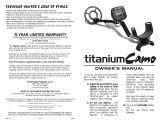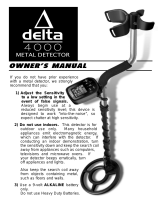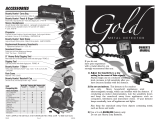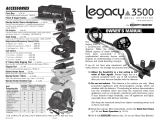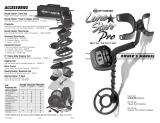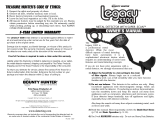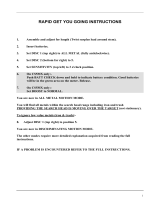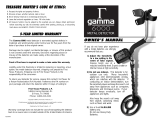Page is loading ...

LandRanger
™
Metal Detector
Owner’s Manual
The new improved Land Ranger™ is a top-of-the-line professional
metal detector with the kind of depth performance and sophisticated
features demanded by the serious metal detector enthusiast. A
large LCD screen displays the current operating status at all times,
and displays probable target type and depth when metal is detected.
All features are either named on the touchpads or displayed on the
screen, making it easy for you to program it the way you want.
The Land Ranger™ can be used as a "turn on and go" metal
detector (see page 4 ). However, you'll find a lot more if you read
the manual to acquaint yourself with the many performance-
enhancing features which the Land Ranger™ offers.
◆ Waterproof searchcoil
◆ Touchpad control panel
◆ Microprocessor-controlled
◆ LCD screen with target ID readout
◆ Readout of ground mineral conditions
◆ Numeric readout of target conductivity
◆ SMART TRAC computerized ground balancing
◆ Programmable target type acceptance or rejection
◆ All Metals Pinpoint mode for pinpointing target position
◆
Self-Tuning all metals mode for maximum depth in mineralized ground
◆
Search for coins, lost jewelry, relics, gold nuggets, and other valuable metals

CONTENTS
Quick Start (if you're really impatient) . . . . . . . . . . . . . . . . . . . . .4
THE BASICS OF METAL DETECTING
Types of metal detecting
-"coinshooting" . . . . . . . . . . . . . . . . . . . . . . . . . . . . . . . . . .5
-relic hunting . . . . . . . . . . . . . . . . . . . . . . . . . . . . . . . . . . .5
-gold prospecting . . . . . . . . . . . . . . . . . . . . . . . . . . . . . . . . .5
-cache hunting . . . . . . . . . . . . . . . . . . . . . . . . . . . . . . . . . .5
-shallow water hunting . . . . . . . . . . . . . . . . . . . . . . . . . . . .6
How metal detectors work . . . . . . . . . . . . . . . . . . . . . . . .6
Capabilities and limitations
-depth . . . . . . . . . . . . . . . . . . . . . . . . . . . . . . . . . . . . . . . . .7
-target identification . . . . . . . . . . . . . . . . . . . . . . . . . . . . . .7
-requirement for motion . . . . . . . . . . . . . . . . . . . . . . . . . . .8
-ground balancing . . . . . . . . . . . . . . . . . . . . . . . . . . . . . . . .8
-discrimination . . . . . . . . . . . . . . . . . . . . . . . . . . . . . . . . . .8
-depth reading . . . . . . . . . . . . . . . . . . . . . . . . . . . . . . . . . . .8
-air testing . . . . . . . . . . . . . . . . . . . . . . . . . . . . . . . . . . . . .9
THE METAL AND PLASTIC STUFF
Easy Assembly Instructions . . . . . . . . . . . . . . . . . . . . . . . . .10
Batteries . . . . . . . . . . . . . . . . . . . . . . . . . . . . . . . . . . . . . . . .11
Headphones . . . . . . . . . . . . . . . . . . . . . . . . . . . . . . . . . . . . . .12
THE CONTROL PANEL
Introduction . . . . . . . . . . . . . . . . . . . . . . . . . . . . . . . . . . . . .12
Touchpad buttons . . . . . . . . . . . . . . . . . . . . . . . . . . . . . . . . .13
Numeric target readout . . . . . . . . . . . . . . . . . . . . . . . .14
Probable Target ID fields . . . . . . . . . . . . . . . . . . . . . . . . .14-15
OPERATION OF THE METAL DETECTOR
Introduction: Selecting operating modes . . . . . . . . . . . . . .16
2

DISCRIMINATION MODES
Preset Program #1 (low discrimination) . . . . . . . . . . . . . . . . .17
Preset Program #2 (medium discrimination) . . . . . . . . . . . . . .17
Preset Program #3 (high discrimination) . . . . . . . . . . . . . . . .17
Discrimination/Target Mode (fully programmable) . . . . . . . . .17
ALL METAL MODES
All Metal Pinpoint mode . . . . . . . . . . . . . . . . . . . . . . . . . . . . .18
SmartTrac (ground balancing) . . . . . . . . . . . . . . . . . . . . . . . . .18
Preset Program #4 (Self-Tuning all metal mode) . . . . . . . . . . .20
SEARCH TECHNIQUE
How to sweep the searchcoil . . . . . . . . . . . . . . . . . . . . . . . . . .21
How to pinpoint targets . . . . . . . . . . . . . . . . . . . . . . . . . . . . .22
Pinpointing a target in the Self-tuning Mode . . . . . . . . . . . . . .22
Retrieving targets . . . . . . . . . . . . . . . . . . . . . . . . . . . . . . . . . .23
False signals and chatter. Using the Sensitivity Control . . . . .24
Estimating target size and depth . . . . . . . . . . . . . . . . . . . . . . .25
Tips on ground balancing . . . . . . . . . . . . . . . . . . . . . . . . . . .26
TYPES OF METAL DETECTING: DESCRIPTIONS AND TIPS
"coinshooting" . . . . . . . . . . . . . . . . . . . . . . . . . . . . . . . . . . . . .28
relic hunting . . . . . . . . . . . . . . . . . . . . . . . . . . . . . . . . . . . . . .29
gold prospecting . . . . . . . . . . . . . . . . . . . . . . . . . . . . . . . . . . .30
cache hunting . . . . . . . . . . . . . . . . . . . . . . . . . . . . . . . . . . . . .32
shallow water hunting . . . . . . . . . . . . . . . . . . . . . . . . . . . . . .33
TROUBLESHOOTING . . . . . . . . . . . . . . . . . . . . . . . . . . . . . . . . . . .34
LEARNING MORE . . . . . . . . . . . . . . . . . . . . . . . . . . . . . . . . . . . . .35
SPECIFICATIONS . . . . . . . . . . . . . . . . . . . . . . . . . . . . . . . . . . . . .36
TREASURE HUNTER'S CODE OF ETHICS . . . . . . . . . . .Back Cover
FIRST TEXAS PRODUCTS WARRANTY . . . . . . . . . . . . . .Back Cover
3

If you want to get started quickly, do the following.
1. Assemble the detector (see instructions on page 10).
2. Install two alkaline 9-volt batteries (see instructions on page 11).
3. Press the Power ON/OFF button. The machine should turn on,
giving several beeps and turning on the LCD screen.
4. When first turned on, the Land Ranger™ starts out in preset
Program #1. This is a "motion discrimination & target ID mode"
with iron and foil rejected. This means that the searchcoil has to
be in motion over a metal object to detect it, and that the
machine will ignore objects which it has decided are probably
iron or foil. .....Sensitivity starts out at medium, which is the
most a beginner should use.
5. If the searchcoil is not in motion and not close to metal, the
detector should be silent. If you experience false signals from
electrical interference, from the soil itself, or from lots of trash
metal, press the Sensitivity minus button to reduce sensitivity.
This will usually make the unwanted signals go away.
6. Toss a coin on the ground and sweep back and forth over it a few
times to get a feel for how the machine responds.
7. You are now ready to search for nonferrous metals such as coins,
to a depth of 6-8 inches under most conditions.
8. The All Metals Pinpoint mode makes recovering a target much
easier. See page 23 for details. Learn to use it at first without
Smart Trac ground balancing.
QUICK START (if you're really impatient)
4

5
THE BASICS OF METAL DETECTING
TYPES OF METAL DETECTING
The Land Ranger™ is suitable for all five of the main types of metal
detecting:
1. "Coinshooting" -- searching for coins, usually in places like
parks and people's yards. Usually there is a lot of aluminum
trash like pulltabs and bottle caps, so ability to distinguish
between metal trash and coins is important. Since coinshooting
is usually done in places where you're not permitted to dig holes
with a shovel, extreme depth capability is not essential. Some
towns have ordinances prohibiting metal detectors in parks, so if
you have any doubt, check first.
2. Relic Hunting-- searching for historical artifacts, including coins,
mostly in places like fields and vacant lots where digging holes is
okay. The most common unwanted metal is iron (nails, fence wire,
parts of wheeled vehicles, etc.) but you may actually be searching
for iron objects. For relic hunting, the important features are
excellent depth capability and the ability to ignore iron metals
(discrimination). Before you go relic hunting, obtain permission
from the property owner. Some public lands are protected by law
from relic hunting, so if you intend to hunt on public land, check
first with the administrator to make sure it's not illegal.
3. Gold Prospecting-- searching for gold nuggets. Because most
nuggets are tiny, high sensitivity is needed. And because gold is
usually associated with iron minerals in the soil, an accurate
ground balancing system is also needed. Ability to identify
targets or to ignore iron is relatively unimportant. It's best to use
a small accessory searchcoil. If you're going gold prospecting,
search in areas where gold is known to be present -- it's very rare
nowadays to discover a new gold location. Learn to recognize
posted claims and don't search on them without first getting
permission. Prospecting clubs often have their own claims which
are open to members.
4. Cache Hunting-- searching for a specific buried cache, typically a
jar or strongbox containing money or gold or silver bullion. This
requires a ground balanced all metals mode. It's best to use an
oversize accessory searchcoil. Always make sure the issue of
ownership is resolved before you dig a cache.

5. Shallow Water Hunting-- All First Texas Products searchcoils are
waterproof, allowing you to search in shallow water. However, if
you're searching around water, please be careful not to get the
electronics housing wet. Because water is electrically
conductive, mimicking the effects of metal, searching in the wet
zone of beaches usually requires sensitivity to be reduced. If it's
salt water, discrimination is usually necessary to avoid false
signals. Avoid salt spray, as it will work its way into the control
housing and damage the electronics-- such damage is not covered
under warranty.
HOW METAL DETECTORS WORK
Most metal detectors for finding buried objects are of the "VLF
Induction Balance" type. Here's how they work.
The searchcoil (also called "search head" or "loop") on the end of the
rod ("stem") contains two electrical induction coils which are like
antennas. The larger (outer) coil transmits a rapidly alternating
magnetic field, "illuminating" the region surrounding the searchcoil.
If metal is present, its electrical conductivity distorts the magnetic
field. If iron metal is present, its magnetism also distorts the
magnetic field, but in a different way, allowing the metal detector to
distinguish between ferrous and nonferrous metals.
The smaller (inner) coil is a receiving antenna which detects changes
in the magnetic field caused by the presence of metal. The
electronic circuit amplifies this weak signal, analyzes it to determine
what kind of change is occurring as the searchcoil is swept past the
metal object, and then conveys the information to the user in the
form of an audio tone and (usually) a visual display of some type.
The iron minerals which are present in most soils also distort the
magnetic field, often obscuring the weaker signals from small or
deeper objects. This can cause the object to go undetected, or to be
misidentified if it is detected. Much of the technology that goes into
modern metal detectors is devoted to the task of eliminating the
unwanted signals from iron minerals in the soil, while not losing the
signals from metals. The technology in the new improved
Land
Ranger™ embodies the knowledge and experience of two of the best
known engineers in the metal detection industry.
6

CAPABILITIES AND LIMITATIONS
DEPTH
The Land Ranger™ can detect U.S. coins to a depth of about 9-11
inches under good conditions. Large objects (55 gallon drums,
manhole covers, etc.) can be detected to a depth of several feet.
Electrical interference from power lines and from electrical
appliances and electronic equipment can reduce detection depth, or
cause audible interference making it necessary for the user to
reduce the sensitivity setting. Soils with large amounts of iron or
salt minerals, may also reduce detection depth or necessitate a
reduction in the sensitivity setting.
TARGET IDENTIFICATION
The Land Ranger™ identifies the probable type of metal object
("target") by measuring its “effective electrical conductivity”, which is
displayed as a number from 1 to 299 on the LCD screen. The
"effective electrical conductivity" of an object depends on its metallic
composition, size, shape, and orientation relative to the searchcoil.
Since coins are minted to tightly controlled specifications, they can
be identified with good accuracy. Identification of pulltabs and foil
is less consistent because these kinds of targets come in wide
variety. In general, smaller objects, and objects made from lower
conductivity alloys such as iron, bronze, brass, lead, pewter, zinc,
etc. will read lower on the effective conductivity scale. Larger
objects and objects made from higher conductivity alloys such as
silver, copper, and aluminum, will tend to read higher. The notable
exceptions are gold, which usually reads low because it's rarely
found in large pieces; and zinc pennies, which read moderately high
because of their size and shape. Although nails and other iron and
steel objects will usually read as iron ring-shaped pieces of iron (for
instance steel washers and harness rings) will usually give medium
to high readings. Flat pieces of iron or steel, such as can lids, will
occasionally do the same.
Most targets can be identified correctly in air out to about 7-10
inches. The minerals in many soils will cause identification to be
less accurate. However in most soils effective target identification
can be had to a depth of at least 4 to 6 inches.
7

REQUIREMENT FOR MOTION
Like other modern metal detectors, the Land Ranger™ searchcoil
must be kept in motion in order to both detect and identify targets.
The All Metal Pinpoint mode continues to detect metal if searchcoil
motion stops over the target. This mode is used primarily to
pinpoint the exact location of a target so that it can be retrieved with
a minimum of digging, and does not provide target identification.
The
Land Ranger™ also features a Self-Tuning All Metal mode in
Program #4. Under most conditions, this is the deepest and most
sensitive mode. It is used primarily for gold prospecting and for
relic hunting in areas where there isn't a lot of metal trash, and
does not provide target identification.
GROUND BALANCING
To achieve maximum depth in both the All Metals Pinpoint and Self-
Tuning all metals modes, the Land Ranger™ offers Smart Trac™
computerized ground balancing to cancel the effects of iron minerals
in the ground. This does not affect the other (discrimination/target
ID) modes. The All Metal Pinpoint mode can be used for pinpointing
objects at moderate depth in most soils without prior ground
balancing.
DISCRIMINATION
"Discrimination" refers to a metal detector's ability to ignore metal
objects in selected categories, especially iron and aluminum. This
makes searching an area where there's a lot of metal trash much
more pleasant. The
Land Ranger™ offers a wide variety of
discrimination features which you can select according to conditions
and your personal preference.
DEPTH READING
The estimated "Depth reading" is based on the strength of the
signal. It is calibrated for typical coin-size objects. Small objects
will read deeper than they actually are, and large objects will read
shallower than they actually are.
8

AIR TESTING
There may be times when you want to test or demonstrate the metal
detector without sweeping it over the ground, for instance if it's not
fully assembled, or if you're indoors. Place the searchcoil in a spot
where it's stable and more than two feet away from any large
masses of metal, including the reinforcing steel which is usually
present in concrete. If you're wearing a wristwatch or jewelry on
your hand or arm, remove it. Then, test or demonstrate by waving
metal objects ("targets") briskly several inches in front of the
searchcoil.
The Smart Trac ground balancing system cannot be tested or
demonstrated in air unless you happen to have appropriate
specimens of iron minerals or electronic ferrite available.
Position of detector and object when air testing the Land Ranger™
9

Getting Started
Assembly
Assembling your Land Ranger™ is
easy and does not require any tools.
Using the following diagram as your
guide, just follow these easy steps.
▲To assemble the
Land Ranger
™
1. Using the supplied bolt and
knurled knob, attach the search
coil to the lower stem. Twist stem
locking nut counter clockwise.
2. Press the button on the upper end
of the lower stem and slide the
lower stem into the upper stem.
Adjust the stem to a length that
lets you maintain a comfortable
upright posture, with your arm
relaxed at your side. Tighten the
stem locking nut.
3. Wind the search coil cable around
the stem. Leave enough slack in
the cable to let you adjust the coil
when you are hunting on uneven
ground. Then tighten the knob at
the end of the search coil.
TIP:
To adjust the coil, simply loosen
the knob.
4. Insert the coil’s plug into the
matching connector on the con-
trol housing. Be sure the holes
and pins line up correctly.
CAUTION:
• Do not force the plug in.
Excess force will cause
damage.
• To disconnect the cable,
pull on the plug. Do not
pull on the cable.
10
Search Coil
Search
Coil
Cable
Upper
Stem
Control
Housing
Plug
Lower
Stem
Lower
Stem
Upper
Stem
Connector
on back of
control housing
Bolt
Knurled
Knob
Bottom view
Bottom side
Stem
locking
nut

11
Batteries
IMPORTANT: Always use ALKALINE batteries only.
Do not use so-called heavy duty batteries.
Always remove the batteries for prolonged storage.
CHECK THE BATTERIES if your detector
exhibits any of the following symptoms:
1. The unit does not turn on.
2. Low speaker volume.
3. Unit beeps continuously or erratically.
The LCD screen shows battery
condition on the lower left.
If the dial indicates "R", replace the batteries. If the dial
indicates "L", the batteries are low and may go dead quickly, so you
may want to replace them. When you replace batteries, replace both
at the same time.
TIP: Battery life is typically about 20 hours, or a little longer if
you use headphones.
▲Follow these steps to install the batteries.
1. Carefully remove the battery compartment door by pressing the
release clip on the right side of the door.
2. Snap one battery onto each of the terminals and place the batter-
ies inside the compartment. Insert both of the batteries with
terminals facing outward.
3, Replace the compartment door by carefully inserting opposite
side of clip first. Then press down on clip side until battery door
snaps into place.
Release
Clip
Alkaline Batteries
Release Clip of
Battery Door

THE CONTROL PANEL
The control panel on the front of the control housing consists
of the following zones:
• along the top, Probable Target ID Fields which are used to
interpret the target signal data displayed on the LCD screen.
• in the middle, an LCD screen which displays operating status
and signal analysis data
• along the bottom and sides, touchpad "buttons" for controlling
operation of the detector
HEADPHONES
The Land Ranger™ is equipped with a standard 1/4 inch
headphone jack for use with any stereo headphone that has a 1/4
inch plug. Use headphones with built-in volume controls, because
without volume controls the sound may be too loud for you.
Using headphones improves battery life, and prevents the sounds
from annoying bystanders. It also allows you to hear more clearly
subtle changes in the sound when
in the All Metal modes,
particularly if you're searching in
a noisy location.
Don't use headphones when
working in an area where it's
necessary to be able to hear for
reasons of safety, for instance
around vehicle traffic, or where
there may be rattlesnakes.
12
Headphone
Jack
1/4 inch
Headphone
Plug
This device is to be used with
interconnecting cables/headphone
cables shorter than three meters.

13
Detector Touch Pads
POWER ON/OFF is used to turn the detector on.
ALL METAL / SMART TRAC is used to select the All
Metal Pinpoint mode of operation, to retune (reset) the
All Metal Pinpoint mode if it has drifted; and, if it is
held down for more than two seconds, to perform the
Smart Trac computerized ground balancing maneuver.
The AUDIO LEVEL buttons are used to control the
audio threshold level in all metals operation.
DISC TARGET
This button selects the programmable-
target Discrimination mode. When already in that mode, if
you tap the button, it activates the Accept and Reject
buttons to allow targets to be programmed to be either
accepted or rejected. When you’re done programming
targets, tap the DISC/TARGET button again to drop back
into Discrimination mode ready to resume searching.
PROGRAM SELECT is used to select one of four predefined
search programs. The first three are discrimination
programs and the fourth is Self-Tuning all metal mode.
ACCEPT and REJECT are used for Target Programming
in the Discrimination mode.
Touch pads
The detector control panel includes several touch pads as shown
and described in the following table. These touch pads are used to
set detector operation.
HIGH (+) and LOW (-) are used to increase or decrease
the detector's sensitivity.

14
Numeric Target I.D. Readout
This table shows the numbers typically associated with certain
commonly encountered nonferrous metal targets. Older silver US
coins usually read about the same as their modern clad equivalents.
Modern quarter-sized dollar coins like the Susan B. Anthony and the
Sacajawea read about the same as a quarter. Most Canadian coins
which are somewhat similar in appearance to U.S. coinage are minted
from a magnetic alloy which gives very inconsistent readings and may
register as iron. Most one-ounce silver bullion rounds will read in the
same range as the modern U.S. $1 Eagle bullion coin.
foil from gum wrapper 1 - 12
U.S. nickel 5¢ coin 20 - 33
aluminum pulltab 29 - 50
aluminum screwcap 55 - 75
zinc penny (post-1982) 68 - 78
aluminum soda pop can 70 - 105
copper penny, clad dime 90 - 100
quarter 25¢ coin, clad 110 - 122
50¢ coin, modern clad 124 - 132
old silver dollar coin 130 - 140
US silver Eagle $1 coin 130 - 165
Probable Target ID fields
The Probable Target ID fields above the top of the LCD screen
represent the signal ranges produced by various coin and metal object
types. When a metal target is detected, the microprocessor analyzes
the signal and categorizes it based on what kinds of metal objects
usually produce that kind of signal. The microprocessor then lights
up an arrow along the top of the LCD screen which points to the
probable target ID field which corresponds to that signal category.
For instance, if the detected signal fits within the parameters
usually exhibited by zinc pennies and the electrically similar
aluminum screwcaps, the microprocessor may categorize the signal
as "zinc penny - aluminum screwcap". The LCD screen will then
point an arrow to the (Z-1¢ S-CAP) field above the LCD screen.
Above the specific target ID fields, there are two general fields, Gold
Range on the left and Silver Range on the right. Most silver jewelry
is larger and of higher conductivity alloy than most gold jewelry, so
silver jewelry will tend to fall to the right and gold to the left.
Since different metal objects can produce similar signals, and since
minerals in the soil can distort the signals, the probable target ID's
are just that-- probable. There is no way of knowing for sure what's
down there other than to dig the target up and see. Experienced
metal detector users have a rule of thumb-- "when in doubt, dig".

15
PROBABLE TARGET ID Fields
Probable Target
ID
GOLD RANGE
SILVER RANGE
IRON / FOIL
Indicates that the target is probably iron or foil. Land Ranger™
has four levels of progressive iron discrimination—from small
to large. Some rusted oxidized iron may occasionally register in
the
SILVER RANGE.
5¢
Located on the top portion of the control panel. The GOLD
RANGE
is located on the left and the SILVER RANGE is on
the right. Other metal types can appear in this range: for
example, iron, foil and nickel appear under
GOLD RANGE
and copper pennies appear under SILVER RANGE.
Description
Indicates that the target is possibly a nickel. Many gold rings
register as
5¢. A percentage of foil and many newer pull-tabs
are still detected as nickels.
Indicates that the object is probably a pull-tab. Some small
gold may also register as a pull tab.
Indicates that the target is probably a zinc penny (post 1982) or
a screw cap. This target ID is usually accompanied by a
medium tone. Other targets, such as large gold, may also
register in this field.
Indicates that the target is out of identification range.
These four fields indicate a coin type or an object or metal
within similar detection range. Many other objects are
identified in this range: for example, copper, brass and
oxidized metals such as cans, jewelry, tokens, medals, or
even junk metal objects that fall in the same range.
Copper pennies (pre-1982) will usually register in the
1¢/10¢ range.
PULL TAB
Z-1¢
S-CAP
DEEP TARGET
1¢
10¢
25¢
50¢
$1
Target Detection Dial
The Target Detection Dial is in the lower right-hand corner of the
LCD screen. When the machine detects a target, an arrow will
point to “+” if the target is accepted, and will point to “-” if the
target is rejected.

16
Introduction: Selecting operating modes
The Land Ranger offers three basic types of operation:
1.
Discrimination with visual target identification. This type of
operation requires the searchcoil to be in motion over the target
for the target to be detected. The Land Ranger offers an array of
discrimination modes: three preprogrammed modes accessed by
the PROGRAM SELECT button, a fully programmable mode
accessed by the DISC/TARGET button.
2.
All Metals "pinpoint". This mode is used primarily for locating
precisely where the object is so that it can be dug with minimum
effort. This mode does not provide target ID, and does not
require the searchcoil to remain in motion.
3.
Self-Tuning mode. This is a high-sensitivity mode which detects
all metals, does not provide target ID, and does require the
searchcoil to remain in motion to detect a target.
When the machine is first turned on, it goes to Preset Program #1.
To access another mode, tap the corresponding button. If the other
mode you want is a different Preset Program, tap the PROGRAM SELECT
button until you've stepped to the one you want, as indicated on the
display screen.
If you are in a mode other than one of the Preset Programs, and tap
the PROGRAM SELECT button to get back to the Preset Program
selection, it will return to the Preset Program you were previously in.
OPERATION OF THE METAL DETECTOR

17
Preset Program #1 (low discrimination)
When the machine is first turned on, it goes to Program #1. This is a
motion discrimination & target ID mode which rejects iron and foil,
as indicated by the
R's under those categories on the display screen.
Preset Program #2 (medium discrimination)
If you're in Program #1 and tap the PROGRAM SELECT button, it'll
step you to Program #2. This program is like Program #1, but it also
rejects pulltabs. Nickels are still accepted.
Preset Program #3 (high discrimination)
If you're in Program #2 and tap the PROGRAM SELECT button, it'll
step you to Program #3. This is a motion discrimination & target ID
mode like Program #2, but it also rejects targets in the zinc penny/
screwcap category, as indicated by the R's under the corresponding
categories. Nickels are still accepted.
If you're in Program #3 and tap the PROGRAM SELECT button
again, it'll step you to Program #4, which is entirely different.
Discrimination/Target system
(fully programmable)
The Discrimination/Target system gives the user the ability to
accept or reject any target category, including 4 levels of iron. Its
discrimination (DISC) mode is accessed by tapping the
DISC/TARGET button. When the machine is first turned on, it
detects ("accepts") all target categories. This makes it handy to use
for ID'ing targets which have been detected in the Self-Tuning all
metals mode (preset Program #4).
When you're already in DISCrimination mode, if you tap the button
again, it switches to TARGET programming mode. In this mode, the
ACCEPT and REJECT buttons are activated, and the machine does
not detect targets because it's waiting for you to enter ACCEPT or
REJECT target category selections. If at any time you are finished
making ACCEPT or REJECT selections, just tap the button again,
and it'll drop back into normal DISC operation.
TARGET PROGRAMMING MODE: In this mode, the machine is
waiting for you to select which target categories you want to accept
(see and hear), or reject (ignore). The machine flashes a blinking
DISCRIMINATION & TARGET ID MODES

18
arrow in the category it's waiting for you to decide. If you want to
accept that category, press ACCEPT and the machine will step to the
next category. It will also erase an R if there had previously been
one. If you want to reject that category, press REJECT and the
machine will place an R under that category to remind you that that
category is now rejected, and the arrow will step to the next
category. When you have the target categories selected the way you
want, just tap the DISC/TARGET button, and it'll drop out of
TARGET programming mode back into DISCrimination mode.
The iron category is a special case. Iron is broken down into four
iron levels, which are indicated below the word TARGET on the
display screen.
Ir1 is small or deep iron objects. Ir2 is small to
medium iron objects, or iron objects which are relatively deep. Ir3
is medium size or depth iron objects. Ir4 is large shallow iron
objects. For certain types of relic hunting you may want to select
some iron categories and reject others; however in general you will
probably want to reject all four categories.
To erase all
R’s, hold the DISC/TARGET button down for 3 seconds.
All Metal Modes
All Metal Pinpoint mode When the ALL METAL-SMART TRAC
button is pushed, the detector switches to the All Metals Pinpoint
Mode. This mode detects all metals and unlike the other modes,
does not require to the searchcoil to remain in motion to detect a
target. However, because this mode tends to drift, you may
frequently have to tap the button again in order to retune (reset) the
signals to zero in order to restore sensitivity. For instructions on
how to pinpoint targets, see page 23.
SmartTrac™ (ground balancing)
Computer-assisted ground balancing increases the usable depth of
the All Metals Pinpoint Mode and the Self-Tuning all metals mode
(Program #4). It does this by cancelling interfering signals from iron
minerals in the ground. This is a feature for the advanced user.

PROCEDURE FOR GROUND BALANCING
1. With the searchcoil more than half a foot above the ground, press
and hold the ALL METAL/SMART TRAC button.
2. Immediately lower the searchcoil to within about half an inch of
the ground.
3. When you hear a wobbly tone (in about 2 seconds), release the
button.
▲The meaning of the beeps.
1. WARNING BEEP After you’ve been holding the button down for 1
second, there’s a beep to remind you not to hold the button
down unless you are intending to ground balance. When the
computer attempts to ground balance, your existing ground
balance setting (if any) will be lost.
2. WOBBLY TONE After you’ve been holding the button down for 2
seconds, there's a wobbly tone which tells you the computer is
ready to ground balance. When you release the button, the
computer will attempt to ground balance.
3. HIGH “SUCCESS” BEEP A high tone after you ground balance
means that the attempt to ground balance was successful.
4. LOW “FAILED ATTEMPT” BEEP A low tone after you’ve attempted
to ground balance means that the attempt failed. The computer
will decide not to ground balance if there is a large piece of metal
under the searchcoil, if the ground is of a type which cannot be
balanced (for instance salt water), or if you lifted rather than
lowered the searchcoil. If the attempt to ground balance fails, the
computer sets the ground balance to zero.
19

▲Ground balance setting display
When you ground balance, the ground balance setting is displayed
briefly on the LCD screen. It is also displayed every time you tap the
ALL METAL/SMART TRAC button.
With a little experience, you’ll know what number to expect where
you hunt. If there is metal where you ground balance, and the
attempt is successful, the number displayed will be higher than
normal. This is one way you can know that you need to try again in
a different spot.
For additional tips on ground balancing, see page 27.
Please note that the Smart Trac feature is for the advanced
user. Beginners should first master using the pinpoint mode
without ground balancing.
Preset Program #4 (Self-Tuning All Metal Mode) Under most
conditions, this is the most sensitive mode in the machine. Its
primary uses are for gold prospecting and for relic hunting in areas
where there's not a lot of unwanted metal trash. This mode requires
the searchcoil to be in motion in order to detect a target, and does
not provide target identification. This mode is for the advanced user,
and is often unusable unless ground balancing has been done first.
If you tap the PROGRAM SELECT button while in Program #4, it'll
recycle the program selection back to Program #1.
▲Audio Level
The all metals modes are most sensitive when the audio level is
adjusted so that a background hum or chatter is just barely audible.
In general, it is best NOT to operate the machine at maximum
sensitivity.
However, a few applications such as gold prospecting may require
maximum sensitivity. Press the audio level + button until you hear a
slight amount of hum or chatter. If you go to far “into the noise” you
can back off using the audio level - button.
20
/
